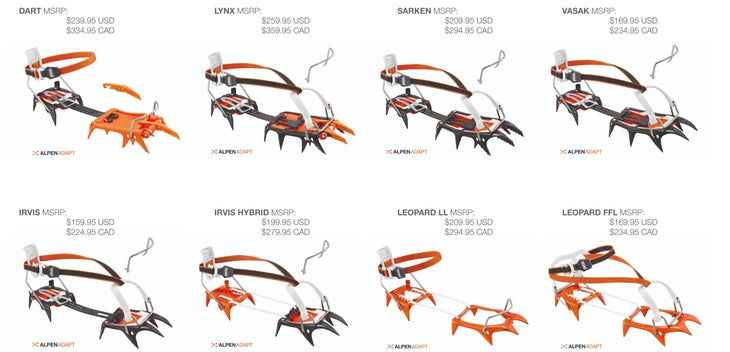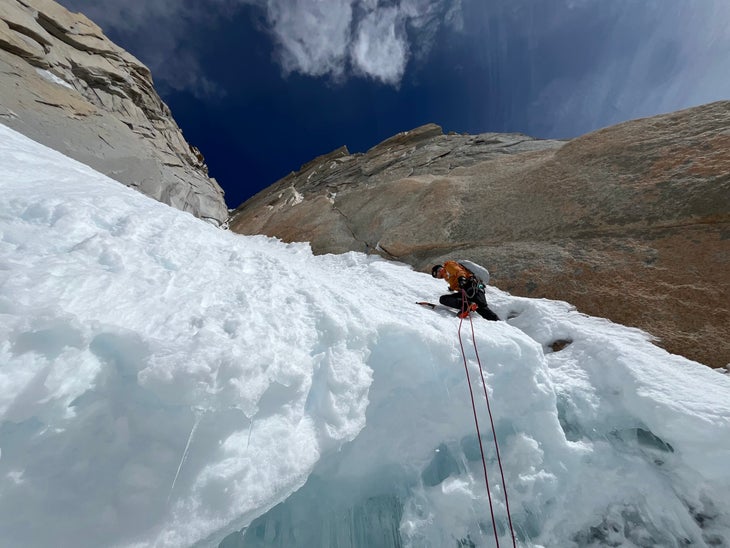Heading out the door? Read this article on the new Outside+ app available now on iOS devices for members! Download the app.
A public service announcement for budding ice climbers and mountaineers: You will very likely need more than one pair of crampons to facilitate all your wild, frost-covered dreams. You might even need three pairs. If you’re a weight-conscious all-arounder like me, you might use upwards of five.
Don’t stop reading. I’m not suggesting you buy five pairs of crampons.
What I am suggesting is that you buy your next pair of crampons wisely, because you will—whether you’re aware of this or not—be investing in the “family” of crampons made by any given brand. For example: You need a general mountaineering crampon, so you buy one with wide horizontal front points, which are great for walking. A year later, you decide to try waterfall ice climbing, and quickly realize your horizontal points displace a ton of ice when kicking. Rather than buy a whole new pair of crampons for steep ice, you can buy just a front section of vertical-point crampons, and slot them into your existing crampon heels. But they’ll need to be made by the same brand to fit.
And here is where I remind you to buy that next pair of crampons wisely.
How Petzl’s Alpen Adapt system works
The folks at Petzl take my PSA seriously. They’ve understood it for years. And it’s why they’ve created “Alpen Adapt”: a labyrinthian network of seven crampons and many more crampon parts which are nearly all interchangeable in some way. Alpen Adapt crampons can take you from a mindless plod up a Himalayan giant (Leopard, an aluminum walking crampon) to some of the hardest water ice on Earth (Dart, a vertical-point, all-steel beast). These crampons really excel somewhere in the middle though, thanks to the customization available, whether that’s adding a Leopard heel to a Dart front, or fitting the crampon itself to a running shoe or ski boot.

While we think that Petzl has the most versatile crampon family around, keen readers will note that Blue Ice produces nine unique crampons with varying accessories. But Blue Ice is a less versatile investment than Petzl for one important reason: You cannot buy their vertical-point crampon with a steel linking bar. It is only available with a supple Dyneema strap—that has failed to perform on a few of my hardest leads.
A second PSA: Why you should be wary of Dyneema-connected crampons
Dyneema-connected crampons are exactly what they sound like: a crampon heel section that is attached to a front section via a soft textile rather than a stiff metal bar. Petzl uses 7mm cord tied with a Fisherman’s knot, while Blue Ice uses a thicker seatbelt-style strap. Such a design is an easy way to shave off weight, but it can also be a big problem, as I first learned, while attempting Nemesis (WI6) on B.C.’s Stanley Headwall. No matter how tightly I fit the Blue Ice crampon to my boot, while kicking into the dense, north-facing ice, the front section would rotate 10-15 degrees away from my body like a duck’s foot. The crampon lacked the lateral rigidity that a metal linking bar provides.
So I called Blue Ice up. Surely I was missing something. The crampon designer told me it was a problem Blue Ice was aware of, and offered that their crampons should not be “a wholesale replacement for a vertical-waterfall crampon.” Without any option to add a metal linking bar to the Blue Ice crampons, I relegated them to long, easy mixed routes—and went back to my all-steel standbys.
A few months later, I was climbing in El Chaltén, Patagonia, and intentionally brought Dyneema-connected crampons onto a climb in the Fitz Roy massif. The 200-gram weight savings felt like an appropriate trade-off to both me and my partner, since the route’s ice climbing was far below our limit, and we were attempting the climb (some 2,000 meters of valley-bottom elevation gain) in just one day. And we were right: the textile linking bars of the Dart-Leopard combo worked just fine. But I remain extremely wary of climbing vertical alpine ice and hard foot-torquing in this setup.

The best crampons for mountaineering
If you are certain you will never want to climb vertical water ice, buy a crampon with triangular, horizontal front points, like the Vasak or Irvis/Ivris Hybrid. If you’re not hiking very far and don’t mind the extra weight, there’s really no downside to the Vasak or Irvis’s metal linking bars. (I’d recommend the Irvis, since its 10 bottom points feel nearly as stable as the Vasak’s 12, and it’s lighter.)
For those who do feel the accumulating weight of a mountaineering pack, however, I would suggest the Irvis Hybrid: a Dyneema-connected crampon with aluminum heel pieces and steel fronts. This is my daily driver while at home in the Canadian Rockies because it’s solid enough to kick into alpine ice (so long as it’s not too steep!), while also being relatively lightweight (570 grams) and packable. If I was climbing the Franco-Argentina on Fitz Roy, or the North Ridge of Mount Stuart, I’d probably bring this one.
The best crampon for non-technical mountaineering
For even less technical mountaineering, or summer alpine rock climbing approaches—think crossing frozen snowfields or flat glaciers—I’d use the fully aluminum Leopard for maximum weight savings (330 grams). Its aluminum bottom points don’t bite into glacial ice as well as the Irvis’s steel, but for slopes less than 35 degrees, the Leopard does the trick for general ski mountaineering, or objectives like the Beckey-Chouinard on the South Howser Tower. A major downside of the Leopard is you can’t just buy the aluminum front section—you need to buy the whole crampon for some baffling reason. Nevertheless, if you buy the entire Leopard first, and then the Irvis’s front section, you will be set for all your mountaineering needs.
Watch Heike Schmitt climb the crux pitch of Juvsøyla (WI5/6) in Rjukan, Norway, wearing the Petzl Dart.
The best crampon for ice and mixed climbing
Finally, if technical ice and mixed climbing is your bag, look no further than the Dart. I have used this crampon on WI6 and M8, on everything from the East Pillar of Torre Egger, to chossy Rockies horror shows, to steep Norwegian pillars. The Dart’s front points can be configured in three orientations (mono point, dual point, or offset dual point) to suit whatever terrain you can throw at it, be it sugary rime ice, knifeblade splitters, or blocky mixed. Petzl also makes the Lynx, another vertical-point crampon, but I think the Dart is the better option. Compared to the Lynx, it’s 120 grams lighter, $20 cheaper, and takes up slightly less space in your pack. The only downside is its limited range: the Dart fits mountain boots from sizes 34 to 44, while the Lynx fits 37 to 49.
